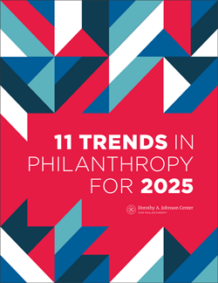The Nonprofit Workforce is in Crisis


 This article was first published in our 11 Trends in Philanthropy for 2025 report. Explore the full report here.
This article was first published in our 11 Trends in Philanthropy for 2025 report. Explore the full report here.
Want the latest trends, research, and more delivered right to your inbox? Subscribe to the Johnson Center email newsletter.
Employee wellbeing remains a trending strategic focus in the workplace, and its significance in the social impact sector will be mission-critical in 2025.
Evidence from the field and global workplace indicators confirm the connection between employee wellness and overall engagement, productivity, and performance (Pendell, 2021). In practice, employee wellness is not easily prioritized in the nonprofit sector, putting the sustainability of the nonprofit workforce and the programs they deliver at risk.
Looking back to the decade between 2007 and 2017, employment at nonprofit organizations grew 18.6%, far outpacing the 6.2% growth seen in private employment for for-profit businesses (Friesenhahn, 2024).
However, that impressive growth has since given way to concerning staffing shortages. In a 2023 survey conducted by the National Council of Nonprofits, nearly 75% of nonprofits reported persistent job vacancies — particularly in program and service delivery roles, where 74% reported vacancies — severely impacting the sector’s ability to serve communities. Half of nonprofit survey respondents indicated vacancies were more prevalent in 2023 compared to pre-pandemic levels.
These vulnerabilities are further magnified by systemic challenges. It is no secret that the reward and rigor of nonprofit leadership often comes with budget constraints and wage inequity, coupled with complex human and social issues and pervasive burnout. The Center for Effective Philanthropy’s report, the State of Nonprofits 2024: What Funders Need to Know, found that 95% of nonprofit leaders were concerned about staff burnout with nearly 50% finding it difficult to fill staff vacancies (Im et al.). Looking to 2025, the forecast reflects an ongoing interplay of economic constraints and talent shortages.
Echoing noted research, the peoplepower is perhaps the most vulnerable. According to a 2024 study by Independent Sector and United for ALICE, in 2022, 22% of nonprofit employees lived in households unable to afford necessities like housing and healthcare. This financial strain disproportionately impacts racial and ethnic minority workers and individuals in social assistance roles, revealing an unfortunate irony where employees providing social services often seek support themselves.
It is unclear whether and when the situation might turn around. Research from the Center for Effective Philanthropy (2024) found that most foundation leaders reported “some degree of understanding about the well-being of staff at the organizations they fund” (p. 1), and that most were also concerned about staff burnout at those organizations. However, only half reported that their foundation engaged in practices to support the wellbeing of staff in grantee organizations, while nonprofit leaders identified funding as one of the biggest barriers “to supporting the mental health or well-being of their staff” (p. 5).
In January 2024, reporting from The Chronicle of Philanthropy shared an especially dire look at the sector’s hiring and retention struggles, and how pervasive and destructive the funding disconnect has become (Rendon). Many nonprofits have closed their doors due to unexpected shifts in funding from long-time partners, and several reported they face significant challenges in identifying the additional support they need to meet the increased expenses of closing wage-equity gaps and improving wellness resources and benefits for staff.
While the pace of inflation has slowed, the higher prices consumers and employers have seen since the start of the pandemic have not reversed — and are not expected to (Mutikani, 2024). Costs for staffing, supplies, infrastructure, and service needs are only expected to rise in the coming years — as is the demand for those services (Rendon, 2024). The stress on organizations and individuals to meet the needs of staff, grantees, and communities will most likely increase as well.
Empirical data and case studies underscore that embedding wellbeing strategies is not just beneficial but essential for a resilient and engaged workforce, and “investing in staff wellbeing is not “merely an expense; it’s an integral investment” (Bancroft, 2023, para. 14).
There are myriad examples of funders, nonprofits, and initiatives that take this wellbeing imperative very seriously. The Imago Dei Fund’s Keep the Spark Alive grants program helps ensure that wellbeing initiatives are prioritized through targeted funding for team retreats, counseling, and wellness programs (Doyle et al., 2024). Similarly, the Walter & Elise Haas Fund’s multi-year unrestricted funding provides organizations the flexibility to allocate resources toward staff care, reinforcing the principle that resilient organizations result in more effective service delivery (Alison, 2023).
There are also many programs and leaders across philanthropy that recognize that addressing the disparities in wellbeing experienced by BIPOC communities is crucial for the stability of the nonprofit sector. In Southeast Michigan, programs like the McGregor Fund’s Rest and Liberation Initiative exemplify sabbaticals and resilience-building cohorts in BIPOC-led nonprofits, a critical need in combating systemic burnout, promoting rest, and reducing stress (Michigan Community Resources, 2023). Katya Fels Smyth (2024) points to a number of projects aimed at reversing “wellbeing stripping” (para. 6), which undermines access to wellbeing, and developing a new understanding of economic stability that includes wellbeing measures.
With these data insights, it is critical to evaluate prominent frameworks that support workplace wellbeing and move to action.
Mindful Philanthropy (n.d.) launched in 2020 as a collaborative of Peg’s Foundation, Well Being Trust, Scattergood Foundation, and The John Heller Fund. The group focuses on galvanizing impactful funding in mental health, wellness, and addiction treatment, and engages and convenes funders around investments in wellbeing.
The U.S. Surgeon General’s Framework for Workplace Mental Health & Wellbeing appeared in 2022 and emphasized worker voice and equity and highlighted Five Essentials: protection from harm, community connection, work-life harmony, mattering at work, and opportunities for growth (Office of the Surgeon General, 2022). The Framework can be used “as a starting point for organizations in updating and institutionalizing policies, processes, and practices” (p. 11).
Today’s workforce expects more from their employers (Rendon, 2024), including work environments that foster transparency, autonomy, and professional growth. Benefits such as mental health support, flexible schedules, and hybrid work arrangements are increasingly seen as baseline expectations, contributing to stronger teams and better retention (Case, 2024; Hughes, 2024).
The U.S. Surgeon General’s framework (2022) offers systems that are critical to practices that advance the wellbeing of workers: “Organizations should build in systems for accountability, review existing worker engagement survey data to better understand the needs among disproportionately impacted groups, utilize validated tools for measuring worker well-being, and ensure processes for continuous quality improvement” (p. 11) so that the sector can do good — for good.


Allison, J. (2023, May 11). The Walter & Elise Haas Fund’s new grantmaking philosophy. Walter & Elise Haas Fund. https://haassr.org/blog/wehf-new-grantmaking-philosophy/
Bancroft, E. (2023, November 28). Why every nonprofit should offer sabbaticals (and how to make it happen). Forbes. https://www.forbes.com/councils/forbesnonprofitcouncil/2023/11/28/why-every-nonprofit-should-offer-sabbaticals-and-how-to-make-it-happen/
Case, T. (2024, September 4). Why employee happiness is starting to hinge more on HR-fostered engagement than hybrid flexibility. WorkLife. https://www.worklife.news/leadership/why-employee-happiness-is-starting-to-hinge-more-on-hr-fostered-engagement-than-hybrid-flexibility/
The Center for Effective Philanthropy. (2024, June). How foundations are supporting grantee staff well-being. https://cep.org/wp-content/uploads/2024/06/CEP_Research_Snapshot_Series_WB_FNL.pdf
Doyle, K., Oakley, J., & Nielsen Jones, E. (2024, August 1). Keeping the spark alive: How one funder invests in grantee well-being. The Center for Effective Philanthropy. https://cep.org/blog/keeping-the-spark-alive-how-one-funder-invests-in-grantee-well-being/
Friesenhahn, E. (2024, January). Nonprofits: A look at national trends in establishment size and employment. Monthly Labor Review, U.S. Bureau of Labor Statistics. https://doi.org/10.21916/mlr.2024.2
Gallup. (2024). Global indicator: Employee wellbeing. Retrieved December 17, 2024 from https://www.gallup.com/394424/indicator-employee-wellbeing.aspx
Hughes, C. (n.d.). Retention and wellness: Preventing nonprofit staff turnover. Swell Fundraising. https://blog.swellfundraising.com/retention-and-wellness-preventing-nonprofit-staff-turnover
Im, C., Grundhoefer, S., & Smith Arrillaga, E. (2024). State of nonprofits 2024: What funders need to know. The Center for Effective Philanthropy. https://cep.org/wp-content/uploads/2024/06/NVP_State-of-Nonprofits_2024.pdf
Independent Sector and United For ALICE. (2024, September 10). ALICE in the nonprofit workforce: A study of financial hardship. https://independentsector.org/resource/financial-insecurity-in-the-nonprofit-workforce/
Michigan Community Resources. (2023). the rest and liberation initiative. https://mi-community.org/rest-and-liberation
Mindful Philanthropy. (n.d.). Our story. https://www.mindfulphilanthropy.org/our-story
Mutikani, L. (2024, November 13). Progress lowering US consumer inflation stalling; rate cut pace uncertain in 2025. Reuters. https://www.reuters.com/markets/us/us-consumer-prices-rise-expected-october-2024-11-13/
National Council of Nonprofits. (2023). 2023 Nonprofit workforce survey results: Communities suffer as nonprofit workforce shortage crisis continues. https://www.councilofnonprofits.org/nonprofit-workforce-shortage-crisis
Office of the Surgeon General. (2022). The U.S. Surgeon General’s framework for workplace mental health & well-being. U.S. Department of Health and Human Services. https://www.hhs.gov/sites/default/files/workplace-mental-health-well-being.pdf
Pendell, R. (2021, March 22). Wellness vs. wellbeing: What’s the difference? Gallup.com. https://www.gallup.com/workplace/340202/wellness-wellbeing-difference.aspx
Rendon, J. (2024, January 17). Nonprofits find ways to manage a staffing crisis with no end in sight. The Chronicle of Philanthropy. https://www.philanthropy.com/article/nonprofits-find-ways-to-manage-a-staffing-crisis-with-no-end-in-sight
Smyth, K. F. (2024, January 17). We have to talk about stripping: What’s been extracted from communities is so much more than financial wealth. Medium. https://medium.com/@katya_3596/we-have-to-talk-about-stripping-f3f8db9f609b